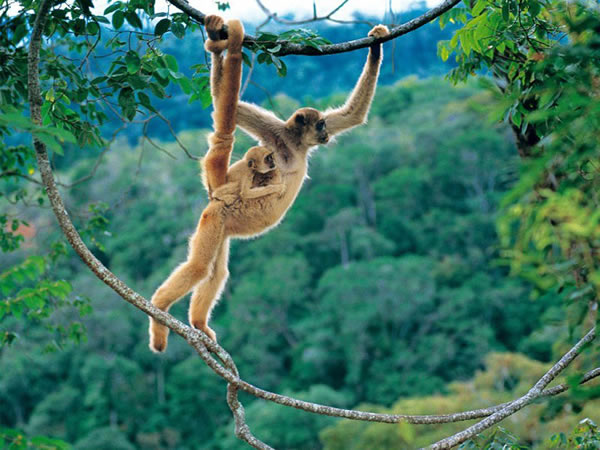 |
| Woolly Spider Monkey |
Description and biology
The woolly spider monkey, or muriqui, is the largest species of New World (Western Hemisphere) monkey. It has an average head and body length of 18 to 25 inches (46 to 64 centimeters) and weighs between 26 and 33 pounds (12 and 15 kilograms). Its prehensile (able to grasp or hold something by wrapping around it) tail is longer than its body, measuring 25 to 32 inches (64 to 81 centimeters) long.
The animal’s head is round and small in relation to its body. Its limbs are long. The fur on its body is thick and gold in color. The fur on its face, arms, and legs is black, although sometimes it may be pink or mottled (spotted or streaked).
The woolly spider monkey lives in the crown of the tallest trees and has never been seen on the ground. It moves through the trees by swinging from branch to branch with its arms. It feeds during the day on leaves, seeds, fruits, and insects.
  |
Most woolly spider monkeys form social groups of 2 to 4 members, although groups of up to 20 or more have been observed in the wild. Mating between males and females may take place at any time. After a gestation (pregnancy) period of four to five months, a female woolly spider monkey gives birth to a single infant.
Habitat and current distribution
The woolly spider monkey prefers to inhabit undisturbed tropical and rain forests. Its range extends only over the south-eastern Brazilian states of São Paulo, Espírito Santo, Rio de Janeiro, and Minas Gerais. Biologists (people who study living organisms) estimate that 200 to 400 of the animals currently exist in the wild.
History and conservation measures
The woolly spider monkey once ranged over all Atlantic coastal forests of eastern and southeastern Brazil. It is estimated that the monkey’s population in the sixteenth century numbered almost 500,000. By 1972, that population had dropped to 2,000.
Today, the animal is almost extinct, and in 2000 the International Union for Conservation of Nature and Natural Resources (IUCN) raised the status of the species from endangered to critically endangered. The woolly spider monkey is, according to the IUCN, one of the most threatened primates remaining in existence in the Atlantic forests of southeastern Brazil.
Since the 1800s, the human population in this region of Brazil has swelled enormously. To feed the growing numbers of people, large tracts of forest have been cleared over the years to provide pasture land for cattle and to create coffee, sugar cane, and cocoa plantations. Logging of these forest areas for their valuable timber has also taken its toll. Only two percent of the original forest cover remains in this region.
In the past, woolly spider monkeys were hunted for food. Although currently protected by law, many may still be taken by hunters in some areas.
Small, isolated groups of the animals exist in protected areas. In the state of Minas Gerais, about 50 monkeys live on a private coffee plantation called Fazenda Montes Claros.
Another group lives on Fazenda Barreiro Rico, a private ranch in São Paulo. Woolly spider monkeys may also be found in the Biological Reserve of Nova Lombardi in Espírito Santo and in other state and national parks in the region.
